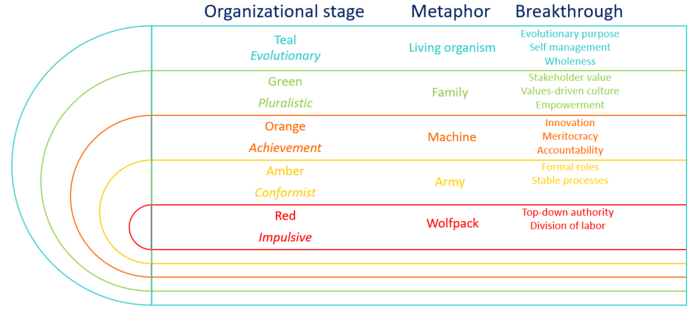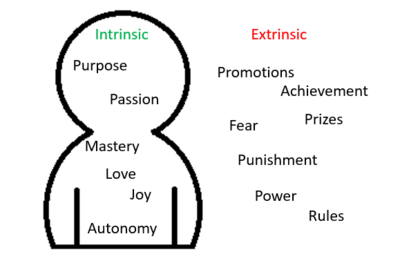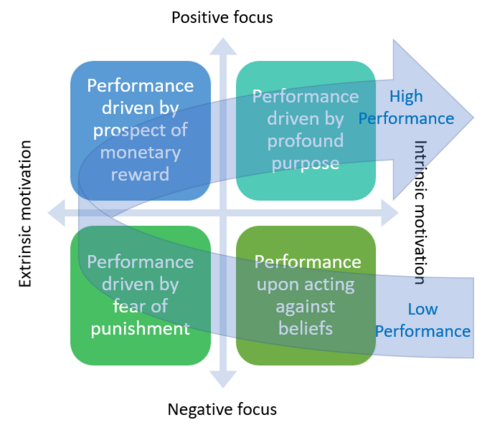Evolutionary purpose in project management
By Søren Bojesen
Contents |
Abstract
In project or programme management, defining purpose is one of the key activities for success. On purpose, The project guide Doing Projects: A Nordic Flavour to Managing Projects [1] states: "Purpose gives a project direction, sets the boundaries of the project, and defines its success... Managing a project from the purpose perspective is about the adventurous and entrepreneurial spirit to dare to dream and turn dreams into reality...". This conception of purpose, is further developed by Frederic Laloux in the book Reinventing organizations [2]. Here, in an organizational context, Laloux describes the power of a profound purpose, which is is valued over profit or competitive advantage. This profound purpose is described as an evolutionary purpose.
This article investigates how an evolutionary purpose can be used as a motivational driver in project and programme management - suggesting that a powerful purpose might be an even more important factor in achieving success with a project or programme, than on-point budgeting and scheduling. The article dives into extrinsic versus intrinsic types of motivation and how these affect the behavior of individuals and performance of teams. The article also gives practical examples of how to listen to evolutionary purpose in project and programme management.
Background
Teal

A new managerial trend is occurring across industries, countries and cultures. A managerial paradigm which is changing the way we view and do organizations. The paradigm has first been described by Belgian management consultant and author Frederic Laloux, as the perception of organizations as living entities where every employee extradites his/her full potential. This is a clear contrast to a more traditional view on organizations, as machines that needs to be steered and controlled and where employees are often constrained by organizational dogma and cultural hierarchy.
This new managerial paradigm has been named teal as the color, and the name is used to distinguish the paradigm from previous paradigms of how we have been organizing ourselves in groups through history as human beings. The historic evolution of organizations is illustrated in Figure 1. Forming the foundation of teal are three pillars; Self-management, wholeness and evolutionary purpose. The concept of evolutionary purpose is the perception, that an organization has a profound sense of purpose and that great things can happen if an organization finds a way to listen to and make decisions based on this evolutionary purpose. [2]
Teal in project management
Laloux doesn't spend much time discussing teal from a project or programme management point of view. This is a consequence of the anti-managerial nature of teal, in which decisions are being made on the floor and no one has the authority over anyone else. Planning and budgeting are not recommended, as he believes these concepts limit agility and flexibility of projects and project deliverables. This, of course is very far from conventional project management practices, as we know from the many standards there are on the topic.
To be able to follow the guidelines of Laloux, requires a highly developed sense of consciousness within an organization and certainly within the governance boards and management teams of projects and programmes - and should the practices of Laloux be followed without such high level of consciousness, the project is at a high risk of shut down (by the governance board, due to mismanagement) or in other ways become a failure as a result of contradicting practices. Ironically, the concept of purpose in project management and the ability to create a purpose in a project is broadly considered a key parameter in succeeding with projects. This is emphasized in the project guide Doing Projects: A Nordic Flavour to Managing Projects, where purpose is described as one of the four main themes of project management, covering broadly from the defining the scope of the project to answering the great underlaying question: Why is this project important? [1]
Therefore, it seems apparent that it should be possible to listen to an evolutionary purpose in project and programme management, while still managing the project using conventional project management approaches. But how exactly does the evolutionary purpose of Laloux differentiate itself from the typical concept of purpose in project management?
The purpose in project management is a sort of managerial concept to motivate the project team and stakeholders, by stating why a project is important. In other words, the project manager or project management team imposes a purpose to a project as an overall context to the project deliverable(s). An evolutionary purpose is different, as it has to come from the project team members or stakeholders themselves, it cannot be imposed. Also, having an evolutionary purpose in a project team would mean having a purpose which would be treasured higher than the project deliverables themselves - which takes the project to a sort-of programme meta-level, where a project failing to produce its deliverables can still be regarded as a success, if the project manages to produce certain benefits in accordance to the evolutionary purpose.
Performance through Purpose
So what does it mean to listen to evolutionary purpose and what exactly can it bring to a project or programme team?
Intrinsic vs. Extrinsic Motivation
Listening to an evolutionary purpose is to do something that makes a difference - because it makes a difference, work in an environment which fulfills - because if fulfills, to act in accordance to one’s world view - because those are your world views. Basically, the things that trigger intrinsic rewards, by motivation through activities or a sense of purpose. Such types of motivation can be quite powerful, especially in a team environment as they build the coherence between people [3] [2].
In relation, there are certain things in project or programme management practices which prevents us from listening to an evolutionary purpose. Examples of this are focusing on the achievement in itself, being driven by the prospect of a reward, acting due to fear of a consequences etc. Such types of motivation are driven by extrinsic rewards. These can be damaging to teams as they will provoke egocentric thinking within individuals and obstruct coherence.
In project environments, there are typically a high focus on schedules, budgets, delivery specifications etc. All of these exercises are being done to ensure that the project stays within the triple constraints: Cost, time and quality. Unfortunately, such focus is driving extrinsic motivation in the project team. This highlights the importance of purpose in projects, to balance the motivational scale towards intrinsic-based motivation and enable a coherent project team. And due to its ultimate consideration, an evolutionary purpose would be even more powerful in doing so.
Motivation and Performance
Motivation is one of the key factors in projects and creating motivation for project members is one of the core leadership tasks for project managers.
John Rodney Turner describes a good leader as one who over long periods of time, inspires a team to perform above its regular performance level. A motivated project team have a higher contribution, ensure higher quality solutions, have higher morals and increase the chances for success in the project significantly. [4]
On the other hand, a demotivated project team increases the risk of conflicts, stress, budget and timeframe overruns and generally jeopardizes the success of the project.
Figure 2 illustrates the combined theory of intrinsic and extrinsic rewards with Rees' general claims about motivation. The figure shows how the angle of rewards and types of motivation in project teams have a direct effect on the performance of the team.
In a typical project, motivation occurs for the individual team member through a monetary reward, perhaps even a promotion or the achievement in itself and what it may count for on the individuals resumé. These are positive angled extrinsic rewards, which will have a positive effect on the performance of the individual - yet it may be harmful for the collaboration in the team, especially in cases of clashing interests.
Moving down in the figure to the area of negative angled extrinsic rewards, decreases the performance of teams drastically. Here, the motivation is driven by fear of punishment or the prospect of the consequences of failure. This is an area we know best from totalitarian regimes, prison camps etc. Historically, the behavioral consequences of being in this area is poor performance and even rebellious tendencies from group members. No organization or project organization should be acting in this area in modern times.
Moving right in the figure, is the area of negative angled intrinsic rewards. This is the area of the lowest performance in the model. Needless to say, no organization should be acting in this area.
Moving back up in the upper right corner of the figure, is the positive angled intrinsic rewards. Here is purpose driven motivation and the highest performance of teams. This is true because, motivation drives individuals to perform and yet doing so in a non-egocentric manner. Motivation increases the individual’s contribution, both in activities but also in the energy and dedication subjected into the objective. There is a personal satisfaction related to doing tasks and a pleasurable sensation which cannot be achieved in any of the other areas of the model. In addition, this sort of behavior is highly contagious.
Listening to evolutionary purpose
So how do you find your evolutionary purpose in your project team?
Laloux mention a number of ways to listen to evolutionary purpose in an organizational context, some of those exercises can be developed into use in a project context as well.
Sensing
The idea of sensing according to Laloux, is to listen to what the organization wants to do. In a teal organization this exercise is quite simple as wholeness and self-management allow the organization to act according to the evolutionary purpose through decisions made by the employees of the organization [2]. However, in most project teams do not possess that level of consciousness that allows wholeness and self-management to take place in its full form. Therefore, the sensing practice is developed into a project workshop to be applicable to any project team, regardless of consciousness. The workshop is a scoping workshop in which the project team has to define their evolutionary purpose for the project.
Basically, this is done by connecting intrinsic benefits to the project scope. Each team member has to come up with a number of intrinsic benefits from his/her perspective or from a societal perspective. Then the group member has to work in iterations with his/her benefits and refine and assess until the person ends with a benefit which the person truly believes in and which motivates the person. Each team members benefit is then developed into a number of goals or sub-goals across the timeline of the project. The goals may divert from the general direction of the project deliverable slightly. However, the goal has to be on the path of the general direction of the project. Several of the benefits can be merged into common project goals, if this is possible. The result, will be a slightly divergent path of intrinsically motivated project goals that lead towards the overall deliverable and success of the project. This might blur the focus of the project, but this is in fact the whole purpose of the exercise.
A project with a strong natural purpose will have project goals that are very much aligned with the direct path towards the project deliverables. In relation, a project with a weak natural purpose will have a more diverging path, but this is also the sort of project that needs additional intrinsic rewards in order to be successful.
If one team member cannot find any intrinsic benefits for him/herself or a societal perspective, then that team member is not right for the team.
If no team members can find any benefits, then the project is simply not worth undertaking.
Once a path of goals has been defined, each team member will sense the evolutionary purpose of the project and the regular scoping exercises can take place with everyone included.
The Empty Chair
While the sensing practice has been developed to define an evolutionary purpose, the empty chair practice helps a project team stay true towards that purpose. The idea of the exercise is to place an empty chair in every project team meeting to symbolize the project and its evolutionary purpose [2]. Anyone participating in the meeting can at any given time take the seat and listen to personify the project. These are some of the questions which the project might ask:
- Do the decisions made and discussions held reflect the purpose of this project?
- Does anything stand out from today’s meeting, in the perspective of the project purpose?
- Are we going in the right direction with this project? At the right pace and at what consequence?
- Is there anything additional, which needs to be addressed in the perspective of the projects purpose?
This practice can easily be used on a daily. Even if no one sits in the chair, the chair still has a strong symbolic value, reminding everyone of the evolutionary purpose of the project.
Limitations
The nature of a teal organization as described by Laloux [2], is contradicting to a project environment to which the concept of an evolutionary purpose is applied to in this very article. Laloux's evolutionary purpose is a consequence of the two other pillars of teal, those are self-management and wholeness. Self-management can be simulated e.g. as described in the subsection about sensing, yet wholeness is difficult as it requires the same level of consciousness to occur naturally as it does through simulation. The problem with that is that if project team members are restrained by organizational dogma - the individuals may not feel free to listen to or act upon an evolutionary purpose. The danger here may be that a purpose from the individuals perspective ends up feeling imposed from management. This is dangerous as it pushes the motivation down into the negatively angled intrisic perspective and this can have severe effects on the performance of the project team, even if only one or few individuals have this perception.
One of the key success criteria for having an evolutionary purpose in a project context is for the purpose to be integrated throughout project management team and accepted by the project governance. Again, Laloux discusses this in an organizational context [2]. Obviously, the project management team needs to buy-in on the purpose. Otherwise there will be contradicting activities which will be harmful for the project to an extent, where operating without an evolutionary purpose - yet on same terms, might be more beneficial for the success of the project. Understandably, there has to be acceptance by the governance team as well. The governance team is typically not involved in the activities of the project - however, it is the responsibility of the governance board to shut down the project in case they lose confidence in the project. The concept of operating by an evolutionary purpose is quite obscure from a conventional project management point of view and probably most governance boards would abandon such a project. Therefore, it is important that the governance board as a minimum accept the conditions under which the project operates.
Annotated bibliography
Reinventing organizations 1st edition (revised).
In this book is the description of a new managerial paradigm and how it may be changing the way we see and do organizations. The book shows the paradigm in a historic context and gives concrete examples of how to embrace the paradigm.
Doing Projects: A Nordic Flavour to Managing Projects 2nd edition.
This book describes purpose as one of the main perspectives in project management, using concepts and ideas from Nordic management culture. The book is based on the international standard for project management ISO 21500:2012 on project management.
The Project Manager as Change Agent: Leadership, Influence and Negotiation 1st edition.
Leadership chapter: leadership and motivation for project managers.
Essentials of Contemporary Management 7th edition.
Motivation chapter: describes the differences between intrinsic and extrinsic rewards and motivations.
References
- ↑ 1.0 1.1 Doing Projects (1st edition, 2017). A Nordic Flavour to Managing Projects. DS Handbook 185:2017 - Forlaget Dansk Standard
- ↑ 2.0 2.1 2.2 2.3 2.4 2.5 2.6 2.7 Reinventing Organizations (1st edition (revised), 2014). A Guide to Creating Organizations Inspired by the Next Stage of Human Consciousness. Frederic Laloux - Nelson Parker
- ↑ Jones, Gareth R., and Jennifer M. George. Essentials of Contemporary Management. (7th edition, 2016) McGraw-Hill Education
- ↑ The project manager as change agent (1st edition, 1999). Leadership, influence and negotiation. Turner, J. Rodney; Grude, K. V.; Thurloway, L. - McGraw-Hill Book Co Ltd
- Managing groups for high performance, Spring 2018 [1]
- Project Team Roles and Responsibilities, Spring 2018 [2]
- Belbin Team Roles, Spring 2018 [3]
- How to successfully go through the Five Stages of Team Development, Fall 2016 [4]
- Group Dynamics and Personality Types, Fall 2014 [5]
- Designing Project Teams, Fall 2014 [6]

